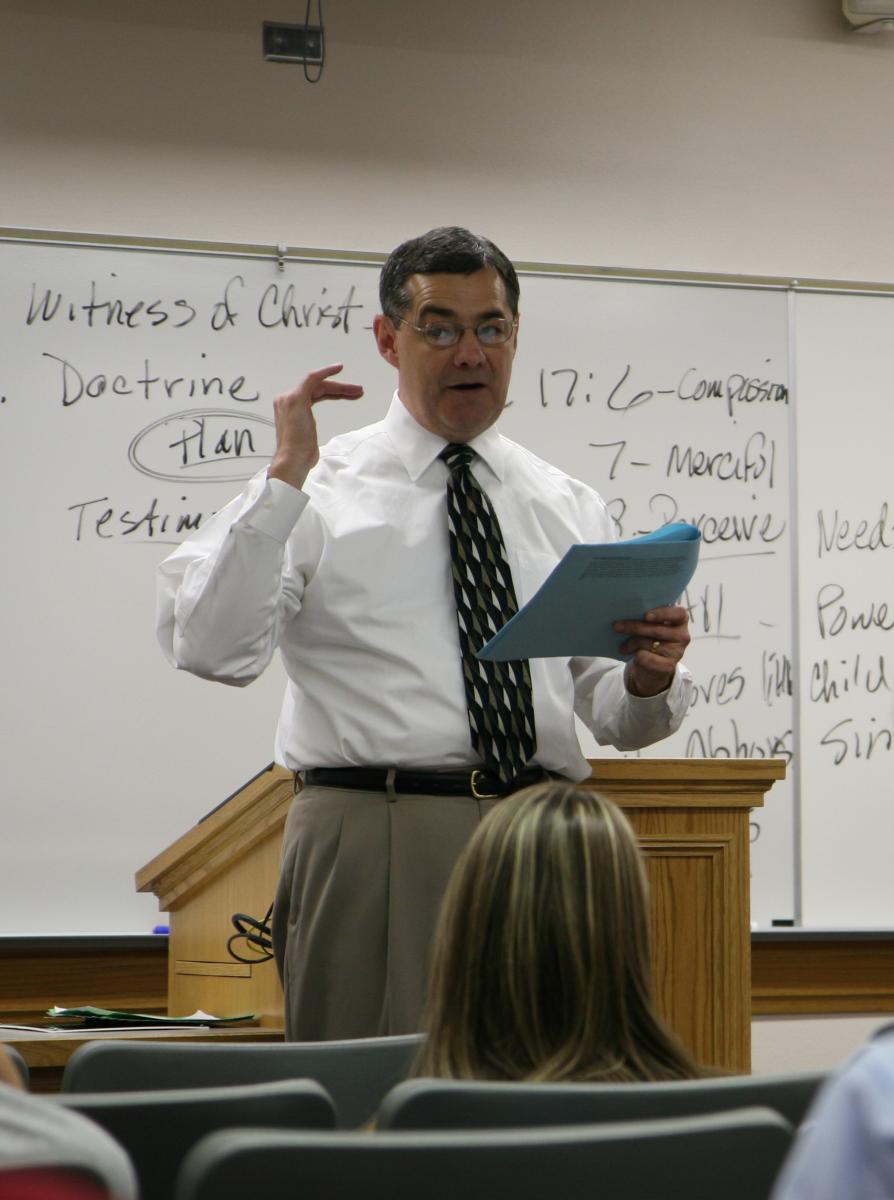Effective Classroom Time Management
Scott H. Knecht
Scott Knecht, “Effective Classroom Time Management,” Religious Educator 10, no. 1 (2009): 89–92.
Scott Knecht (knechtsh@ldsces.org) was assistant to the area director of seminaries and institutes in southern California when this was written.
 An unrushed atmosphere is absolutely essential. Courtesy of Richard B. Crookston.
An unrushed atmosphere is absolutely essential. Courtesy of Richard B. Crookston.
Of all the teacher’s roles, one of the least discussed is timekeeper. Along with everything else, it almost seems silly that a teacher would have to assume this additional role. But if the teacher does not take the role of timekeeper, it is left undone. All class periods are bound by both a starting time and a stopping time, and within that framework a teacher needs to introduce an idea, encourage and allow for student learning in a variety of ways, and bring everything together in a way that helps students want to change for the better. Since we are bound by time, we should make time our friend instead of our enemy.
In the February 2007 worldwide leadership training meeting, Elder Jeffrey R. Holland said, “An unrushed atmosphere is absolutely essential if you are to have the Spirit of the Lord present in your class. Please don’t ever forget that. Too many of us rush. We rush right past the Spirit of the Lord trying to beat the clock in some absolutely unnecessary footrace.”[1] Teachers must be the creators and maintainers of that unrushed atmosphere, even as they guide their students to learning.
How many of these scenarios sound familiar?
- The class begins and the teacher starts by saying, “We have a lot of material to cover today, and I don’t know if we have the time, so we will just do our best.”
- The class is rolling along smoothly until ten to fifteen minutes before the end when the teacher notices the clock and in a panic says, “We are never going to get this all in,” and then races to the end of class.
- The time to end the class has arrived, and the teacher is still talking. Now the time is past, and students are fidgeting, packing up their things, and starting to leave, one by one. The teacher pleads for them to stay to cover “just one more important point.”
All these scenarios result from poor time management. When teachers cannot manage their time, the Spirit feels a little less welcome. Student learning suffers.
A friend, an excellent public schoolteacher, said, “Time does not belong solely to the teacher. For the moments we teach, ownership of time is shared jointly between us and our students. To think that it is solely our own is a gross misassumption.” Teachers have an obligation as they plan their lessons to stay within the given time parameters, for their sake and for the students’. Obviously not all material will be addressed, taught, and learned, but part of the teacher’s duty is “selective neglect,” deciding which parts will receive attention and which will not. It is also not as important to cover material as it is to help your students personally uncover it. Generally a race against the clock covers more material, but this is a poor way for students to learn. Sometimes less is more. Consider these points:
- In gospel education, it probably will not be the only time that a student studies the book of scripture you are teaching in your course. Over a lifetime we will all cycle through the four standard works many times. Different principles and doctrines will be highlighted each time through, whether it is in a class or in personal study. It would be foolish to think that the burden of exposing students to everything in a block of scripture falls on one teacher in one class.
- An unspoken contract exists between teacher and student. Teachers generally like to start on time and want all of the students there to begin together. The flip side of the obligation is that students expect a teacher to end the class on time. Students have other duties to attend to—other classes, employment, study, social time, and so forth. When we as teachers do not uphold our end of the deal, we frustrate students, and the rising frustration level does not enhance the atmosphere.
- What would cause a teacher to go over time? Often teachers say they just lost track of time, which is understandably easy to do. The simple solution is to remember that part of controlling the class is to control the pacing, so we need to make that part of what we do as teachers. Other reasons teachers gave for going over time are that the class was going so well or that the students were so engaged, it was just difficult to stop. In almost all those cases, I have observed that it was not so much the students but the teachers who were engaged in telling a story or sharing some of their thoughts and feelings with the class. When teachers hold a class over so that they can keep talking, the class generally has descended to teaching-as-telling, and that is a very ineffective way for students to learn.
Below are five ideas to make time your ally and not your enemy:
- Think of timekeeping issues as you prepare your lesson. Ask yourself some of these questions: About how long do I think this discussion will go? What follow-up questions are likely to ensue from this main question? What are some of the points I hope will emerge from this activity? How much time do we need at the end of class to allow for effective application? And perhaps the most important question: What are we really trying to do in class today—cover a lot of material, or help students really learn some important principles and doctrines?
- Make yourself aware of the time in a class. Learn to glance at the clock or your watch on a regular basis. Make some visible marks on your lesson plan of the approximate times that you expect to be at certain spots. Stay aware of where you are and where you would like to be.
- Manage the discussion in class. Some students like to ramble and dominate the time. Learn to gently help them summarize and tighten things up. Do not be afraid to say things like, “Let’s take just one more comment on this issue then move on.” Every class seems to have some students who want to stay on a topic longer and some who have had enough. It is the teacher’s job to keep the majority of the students engaged and interested so they will inquire and learn. That may require you to keep moving. Moving along is hard when students want to keep talking. We always seek more input from students, and we solicit more comments. When students begin to participate it always feels good, so it seems counterintuitive to stop taking comments on a subject in order to move on. But if the Spirit is in the class and the students are engaged, trust that when you move on to continue the learning process they will stay engaged, and they will begin to see links and connections between their own life and a variety of scriptural passages, principles, and doctrines.
- Do not make negative statements about the time. Students rarely, if ever, know how much their teachers think they need to accomplish in a given period. We make time our enemy when we play slave to the clock, then verbalize it to the class (“Look at the time—there’s never enough time!”). Be sufficiently aware of where you are so that students will have enough time to digest what is going on, and you will have enough to be able to challenge them to make positive changes, all within the framework of the allotted time. Announcing your frustration with the lack of time only serves to pass that frustration on to the students. They do not need it, and it does not help anything.
- Always stay susceptible to the promptings of the Spirit. Our best efforts at planning and pacing may need to be revised when we hit a real point of testimony and power. The Spirit will tell us when that is, and we should learn to respond to it. But there are also times when the Spirit will suggest that we move on to be able to get to one of those points of testimony and power. The teacher has to summon the courage to lead the class to that point, even if it means shortening something else.
The ideal situation seems to be that we are able to create in the class a safe atmosphere in which students can ask, respond, create, testify, and change, all within the allotted time for the class. Some classes are fifty minutes, some ninety, and some two hours or more. The teacher who learns how to do all of that within the time allotted not only creates that “unrushed atmosphere” that Elder Holland speaks of, but also honors the time and agency of the students, thus edifying them. The more edified they feel, the easier it is to help them learn.
Notes
[1] Jeffrey R. Holland, “Teaching and Learning in the Church,” Ensign, June 2007, 91.
